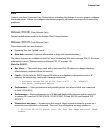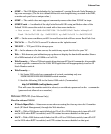
242
Software Fixes
■ STP/Startup-Config — When a startup-config file containing an 802.1D STP configuration
is reloaded that was saved off from the switch, an error similar to the following occurs:
Line: 13. Invalid input: stp802.1d
Corrupted download file.
■ TACACS+ — When logging into the switch via TACACS+ encrypted authentication, the
packet header has the 'encryption' field set to 'TAC_PLUS_CLEAR' when the body of the
packet is actually encrypted.
■ Time Zone — The time zone changes made for PR_4524 are not transparent to the end user.
■ VLAN — New vlans have no members when creating/deleting lots (>30) of unique vids.
■ VTP/ISL — The switch does not forward Cisco VLAN Trunk Protocol (VTP) or Inter-Switch
Link (ISL) packets.
■ Web-Browser Interface — After clearing the intrusion flag in the Web-browser interface,
the intruder flags are not removed.
■ Web-Browser Interface — Configuring static learning for port security may result in the
error message "error in pdu".
■ Web-Browser Interface — The product registration screen contains a typographical error.
(Fix: The phrase "...does not appears above..." is now "...does not appear above...".)
Release F.05.09 (Beta Release Only)
Fixed in release F.05.09
■ GVRP — If GVRP is disabled on a port (to prevent GVRP from being active on that port),
then any VLANs statically configured on that port will not be advertised out (other) GVRP-
active ports.
Release F.05.10 (Beta Release Only)
Fixed in release F.05.10
■ STP — The issue only occurs when this device, running STP in 802.1w mode, has an 802.1D
immediate upstream neighbor. Various possible symptoms, including: i. Topology Change
count increments an excessive number of times after a physical topology change. (Note:
Even with the fix, the Topology Change count increments by more than one for a single
change, which is expected behavior.); ii. Topology Change count increments for much longer
than 30 seconds after a physical topology change; iii. After a physical topology change, the
spanning tree may take a long time to re-converge, and may never re-converge; iv. Possible
flooding storms (which users may mistakenly report as broadcast storms).


















